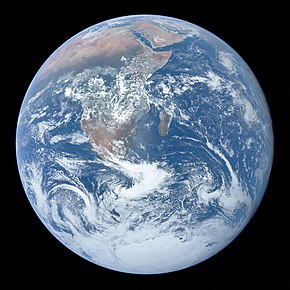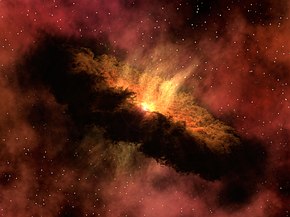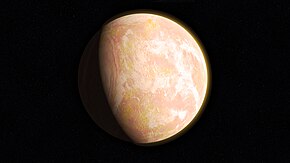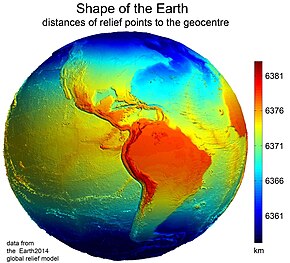Earth
Earth
"Planet Earth" redirects here. For other uses, see Earth (disambiguation) and Planet Earth (disambiguation).
Earth Earth as seen from outer space; the image, known as The Blue Marble, was taken by the crew of Apollo 17 on 7 December 1972
Earth as seen from outer space; the image, known as The Blue Marble, was taken by the crew of Apollo 17 on 7 December 1972
DesignationsAlternative namesThe world, the globe, Sol III, Terra, Tellus, Gaia, Mother EarthAdjectivesEarthly, terrestrial, terran, tellurianSymbol and
and  Orbital characteristicsEpoch J2000[n 1]Aphelion152097597 km (94509065 mi)Perihelion147098450 km (91402740 mi)[n 2]Semi-major axis149598023 km (92955902 mi)[1]Eccentricity0.0167086[1]Orbital period (sidereal)365.256363004 d[2]
Orbital characteristicsEpoch J2000[n 1]Aphelion152097597 km (94509065 mi)Perihelion147098450 km (91402740 mi)[n 2]Semi-major axis149598023 km (92955902 mi)[1]Eccentricity0.0167086[1]Orbital period (sidereal)365.256363004 d[2]
(1.00001742096 aj)Average orbital speed29.7827 km/s[3]
- (107218 km/h; 66622 mph)Mean anomaly358.617°Inclination7.155° to the Sun's equator;
- 1.57869°[4] to invariable plane;
- 0.00005° to J2000 ecliptic
- Longitude of ascending node−11.26064°[3] to J2000 eclipticTime of perihelion2023-Jan-04[5]Argument of perihelion114.20783°[3]Satellites1, the MoonPhysical characteristicsMean radius6371.0 km (3958.8 mi)[6]Equatorial radius6378.137 km (3963.191 mi)[7][8]Polar radius6356.752 km (3949.903 mi)[9]Flattening1/298.257222101 (ETRS89)[10]Circumference40075.017 km
- (24901.461 mi), equatorial[8]
- 40007.86 km
- (24859.73 mi), meridional[11][n 3]
Surface areaTotal: 510072000 km2
(196940000 sq mi)[12][n 4]
Land: 148940000 km2
(57510000 sq mi) – 29.2%
Water: 361132000 km2
(139434000 sq mi) – 70.8%Volume1.08321×1012 km3 (2.59876×1011 cu mi)[3]Mass5.972168×1024 kg (1.31668×1025 lb)[13]Mean density5.5134 g/cm3 (0.19918 lb/cu in)[3]Surface gravity9.80665 m/s2 (1 g; 32.1740 ft/s2)[14]Moment of inertia factor0.3307[15]Escape velocity11.186 km/s[3]
(40270 km/h; 25020 mph)Synodic rotation period1.0 d
(24h 00 m 00s)Sidereal rotation period0.99726968 d[16]
(23h 56 m 4.100s)Equatorial rotation velocity0.4651 km/s[17]
- (1674.4 km/h; 1040.4 mph)Axial tilt23.4392811°[2]Albedo0.367 geometric[3]
- 0.306 Bond[3]
- Temperature255 K (−18 °C; −1 °F) (blackbody temperature)[18]Surface temp.minmeanmaxCelsius−89.2 °C[19]14.76 °C[20]56.7 °C[21]Fahrenheit−128.5 °F58.568 °F134.0 °FSurface equivalent dose rate0.274 μSv/h[22]Absolute magnitude (H)−3.99AtmosphereSurface pressure101.325 kPa (at sea level)Composition by volume78.08% nitrogen (N2; dry air)[3]
- 20.95% oxygen (O2)[3]
- ≤1% water vapor (climate variable)[3]
- 0.9340% argon[3]
- 0.0415% carbon dioxide[3]
- 0.00182% neon[3]
- 0.00052% helium[3]
- 0.00017% methane[3]
- 0.00011% krypton[3]
- 0.00006% hydrogen[3]
Earth is the third planet from the Sun and the only astronomical object known to harbor life. This is enabled by Earth being a water world, the only one in the Solar System sustaining liquid surface water. Almost all of Earth's water is contained in its global ocean, covering 70.8% of Earth's crust. The remaining 29.2% of Earth's crust is land, most of which is located in the form of continental landmasses within one hemisphere, Earth's land hemisphere. Most of Earth's land is somewhat humid and covered by vegetation, while large sheets of ice at Earth's polar deserts retain more water than Earth's groundwater, lakes, rivers and atmospheric water combined. Earth's crust consists of slowly moving tectonic plates, which interact to produce mountain ranges, volcanoes, and earthquakes. Earth has a liquid outer core that generates a magnetosphere capable of deflecting most of the destructive solar winds and cosmic radiation.
Earth has a dynamic atmosphere, which sustains Earth's surface conditions and protects it from most meteoroids and UV-light at entry. It has a composition of primarily nitrogen and oxygen. Water vapor is widely present in the atmosphere, forming clouds that cover most of the planet. The water vapor acts as a greenhouse gas and, together with other greenhouse gases in the atmosphere, particularly carbon dioxide (CO2), creates the conditions for both liquid surface water and water vapor to persist via the capturing of energy from the Sun's light. This process maintains the current average surface temperature of 14.76 °C, at which water is liquid under atmospheric pressure. Differences in the amount of captured energy between geographic regions (as with the equatorial region receiving more sunlight than the polar regions) drive atmospheric and ocean currents, producing a global climate system with different climate regions, and a range of weather phenomena such as precipitation, allowing components such as nitrogen to cycle.
Earth is rounded into an ellipsoid with a circumference of about 40,000 km. It is the densest planet in the Solar System. Of the four rocky planets, it is the largest and most massive. Earth is about eight light-minutes away from the Sun and orbits it, taking a year (about 365.25 days) to complete one revolution. Earth rotates around its own axis in slightly less than a day (in about 23 hours and 56 minutes). Earth's axis of rotation is tilted with respect to the perpendicular to its orbital plane around the Sun, producing seasons. Earth is orbited by one permanent natural satellite, the Moon, which orbits Earth at 384,400 km (1.28 light seconds) and is roughly a quarter as wide as Earth. The Moon's gravity helps stabilize Earth's axis, and also causes tides which gradually slow Earth's rotation. As a result of tidal locking, the same side of the Moon always faces Earth.
Earth, like most other bodies in the Solar System, formed 4.5 billion years ago from gas in the early Solar System. During the first billion years of Earth's history, the ocean formed and then life developed within it. Life spread globally and has been altering Earth's atmosphere and surface, leading to the Great Oxidation Event two billion years ago. Humans emerged 300,000 years ago in Africa and have spread across every continent on Earth with the exception of Antarctica. Humans depend on Earth's biosphere and natural resources for their survival, but have increasingly impacted the planet's environment. Humanity's current impact on Earth's climate and biosphere is unsustainable, threatening the livelihood of humans and many other forms of life, and causing widespread extinctions.[23]
Etymology
The Modern English word Earth developed, via Middle English, from an Old English noun most often spelled eorðe.[24] It has cognates in every Germanic language, and their ancestral root has been reconstructed as *erþō. In its earliest attestation, the word eorðe was used to translate the many senses of Latin terra and Greek γῆ gē: the ground, its soil, dry land, the human world, the surface of the world (including the sea), and the globe itself. As with Roman Terra/Tellūs and Greek Gaia, Earth may have been a personified goddess in Germanic paganism: late Norse mythology included Jörð ("Earth"), a giantess often given as the mother of Thor.[25]
Historically, "earth" has been written in lowercase. Beginning with the use of Early Middle English, its definite sense as "the globe" was expressed as "the earth". By the era of Early Modern English, capitalization of nouns began to prevail, and the earth was also written the Earth, particularly when referenced along with other heavenly bodies. More recently, the name is sometimes simply given as Earth, by analogy with the names of the other planets, though "earth" and forms with "the earth" remain common.[24] House styles now vary: Oxford spelling recognizes the lowercase form as the most common, with the capitalized form an acceptable variant. Another convention capitalizes "Earth" when appearing as a name, such as a description of the "Earth's atmosphere", but employs the lowercase when it is preceded by "the", such as "the atmosphere of the earth"). It almost always appears in lowercase in colloquial expressions such as "what on earth are you doing?"[26]
The name Terra /ˈtɛrə/ occasionally is used in scientific writing and especially in science fiction to distinguish humanity's inhabited planet from others,[27] while in poetry Tellus /ˈtɛləs/ has been used to denote personification of the Earth.[28] Terra is also the name of the planet in some Romance languages, languages that evolved from Latin, like Italian and Portuguese, while in other Romance languages the word gave rise to names with slightly altered spellings, like the Spanish Tierra and the French Terre. The Latinate form Gæa or Gaea (English: /ˈdʒiː.ə/) of the Greek poetic name Gaia (Γαῖα; Ancient Greek: [ɡâi̯.a] or [ɡâj.ja]) is rare, though the alternative spelling Gaia has become common due to the Gaia hypothesis, in which case its pronunciation is /ˈɡaɪ.ə/ rather than the more classical English /ˈɡeɪ.ə/.[29]
There are a number of adjectives for the planet Earth. The word "earthly" is derived from "Earth". From the Latin Terra comes terran /ˈtɛrən/,[30] terrestrial /təˈrɛstriəl/,[31] and (via French) terrene /təˈriːn/,[32] and from the Latin Tellus comes tellurian /tɛˈlʊəriən/[33] and telluric.[34]
Natural history
Main articles: History of Earth and Timeline of natural history
Formation
Further information: Early Earth and Hadean A 2012 artistic impression of the early Solar System's protoplanetary disk from which Earth and other Solar System bodies were formed
A 2012 artistic impression of the early Solar System's protoplanetary disk from which Earth and other Solar System bodies were formed
The oldest material found in the Solar System is dated to 4.5682+0.0002
−0.0004 Ga (billion years) ago.[35] By 4.54±0.04 Ga the primordial Earth had formed.[36] The bodies in the Solar System formed and evolved with the Sun. In theory, a solar nebula partitions a volume out of a molecular cloud by gravitational collapse, which begins to spin and flatten into a circumstellar disk, and then the planets grow out of that disk with the Sun. A nebula contains gas, ice grains, and dust (including primordial nuclides). According to nebular theory, planetesimals formed by accretion, with the primordial Earth being estimated as likely taking anywhere from 70 to 100 million years to form.[37]
Estimates of the age of the Moon range from 4.5 Ga to significantly younger.[38] A leading hypothesis is that it was formed by accretion from material loosed from Earth after a Mars-sized object with about 10% of Earth's mass, named Theia, collided with Earth.[39] It hit Earth with a glancing blow and some of its mass merged with Earth.[40][41] Between approximately 4.1 and 3.8 Ga, numerous asteroid impacts during the Late Heavy Bombardment caused significant changes to the greater surface environment of the Moon and, by inference, to that of Earth.[42]
After formation
Main article: Geological history of Earth Pale orange dot, an artist's impression of Early Earth, featuring its tinted orange methane-rich early atmosphere[43]
Pale orange dot, an artist's impression of Early Earth, featuring its tinted orange methane-rich early atmosphere[43]
Earth's atmosphere and oceans were formed by volcanic activity and outgassing.[44] Water vapor from these sources condensed into the oceans, augmented by water and ice from asteroids, protoplanets, and comets.[45] Sufficient water to fill the oceans may have been on Earth since it formed.[46] In this model, atmospheric greenhouse gases kept the oceans from freezing when the newly forming Sun had only 70% of its current luminosity.[47] By 3.5 Ga, Earth's magnetic field was established, which helped prevent the atmosphere from being stripped away by the solar wind.[48]
As the molten outer layer of Earth cooled it formed the first solid crust, which is thought to have been mafic in composition. The first continental crust, which was more felsic in composition, formed by the partial melting of this mafic crust.[49] The presence of grains of the mineral zircon of Hadean age in Eoarchean sedimentary rocks suggests that at least some felsic crust existed as early as 4.4 Ga, only 140 Ma after Earth's formation.[50] There are two main models of how this initial small volume of continental crust evolved to reach its current abundance:[51] (1) a relatively steady growth up to the present day,[52] which is supported by the radiometric dating of continental crust globally and (2) an initial rapid growth in the volume of continental crust during the Archean, forming the bulk of the continental crust that now exists,[53][54] which is supported by isotopic evidence from hafnium in zircons and neodymium in sedimentary rocks. The two models and the data that support them can be reconciled by large-scale recycling of the continental crust, particularly during the early stages of Earth's history.[55]
New continental crust forms as a result of plate tectonics, a process ultimately driven by the continuous loss of heat from Earth's interior. Over the period of hundreds of millions of years, tectonic forces have caused areas of continental crust to group together to form supercontinents that have subsequently broken apart. At approximately 750 Ma, one of the earliest known supercontinents, Rodinia, began to break apart. The continents later recombined to form Pannotia at 600–540 Ma, then finally Pangaea, which also began to break apart at 180 Ma.[56]
The most recent pattern of ice ages began about 40 Ma,[57] and then intensified during the Pleistocene about 3 Ma.[58] High- and middle-latitude regions have since undergone repeated cycles of glaciation and thaw, repeating about every 21,000, 41,000 and 100,000 years.[59] The Last Glacial Period, colloquially called the "last ice age", covered large parts of the continents, to the middle latitudes, in ice and ended about 11,700 years ago.[60]
Origin of life and evolution
Main articles: Origin of life, Earliest known life forms, and History of life An artist's impression of the Archean, the eon after Earth's formation, featuring round stromatolites, which are early oxygen-producing forms of life from billions of years ago. After the Late Heavy Bombardment, Earth's crust had cooled, its water-rich barren surface is marked by continents and volcanoes, with the Moon still orbiting Earth half as far as it is today, appearing 2.8 times larger and producing strong tides.[61]
An artist's impression of the Archean, the eon after Earth's formation, featuring round stromatolites, which are early oxygen-producing forms of life from billions of years ago. After the Late Heavy Bombardment, Earth's crust had cooled, its water-rich barren surface is marked by continents and volcanoes, with the Moon still orbiting Earth half as far as it is today, appearing 2.8 times larger and producing strong tides.[61]
Chemical reactions led to the first self-replicating molecules about four billion years ago. A half billion years later, the last common ancestor of all current life arose.[62] The evolution of photosynthesis allowed the Sun's energy to be harvested directly by life forms. The resultant molecular oxygen (O2) accumulated in the atmosphere and due to interaction with ultraviolet solar radiation, formed a protective ozone layer (O3) in the upper atmosphere.[63] The incorporation of smaller cells within larger ones resulted in the development of complex cells called eukaryotes.[64] True multicellular organisms formed as cells within colonies became increasingly specialized. Aided by the absorption of harmful ultraviolet radiation by the ozone layer, life colonized Earth's surface.[65] Among the earliest fossil evidence for life is microbial mat fossils found in 3.48 billion-year-old sandstone in Western Australia,[66] biogenic graphite found in 3.7 billion-year-old metasedimentary rocks in Western Greenland,[67] and remains of biotic material found in 4.1 billion-year-old rocks in Western Australia.[68][69] The earliest direct evidence of life on Earth is contained in 3.45 billion-year-old Australian rocks showing fossils of microorganisms.[70][71]
During the Neoproterozoic, 1000 to 539 Ma, much of Earth might have been covered in ice. This hypothesis has been termed "Snowball Earth", and it is of particular interest because it preceded the Cambrian explosion, when multicellular life forms significantly increased in complexity.[72][73] Following the Cambrian explosion, 535 Ma, there have been at least five major mass extinctions and many minor ones.[74] Apart from the proposed current Holocene extinction event, the most recent was 66 Ma, when an asteroid impact triggered the extinction of the non-avian dinosaurs and other large reptiles, but largely spared small animals such as insects, mammals, lizards and birds. Mammalian life has diversified over the past 66 Mys, and several million years ago an African ape species gained the ability to stand upright.[75][better source needed] This facilitated tool use and encouraged communication that provided the nutrition and stimulation needed for a larger brain, which led to the evolution of humans. The development of agriculture, and then civilization, led to humans having an influence on Earth and the nature and quantity of other life forms that continues to this day.[76]
Future
Main article: Future of Earth
See also: Global catastrophic risk Conjectured illustration of the scorched Earth after the Sun has entered the red giant phase, about 5–7 billion years from now
Conjectured illustration of the scorched Earth after the Sun has entered the red giant phase, about 5–7 billion years from now
Earth's expected long-term future is tied to that of the Sun. Over the next 1.1 billion years, solar luminosity will increase by 10%, and over the next 3.5 billion years by 40%.[77] Earth's increasing surface temperature will accelerate the inorganic carbon cycle, reducing CO2 concentration to levels lethally low for plants (10 ppm for C4 photosynthesis) in approximately 100–900 million years.[78][79] The lack of vegetation will result in the loss of oxygen in the atmosphere, making animal life impossible.[80] Due to the increased luminosity, Earth's mean temperature may reach 100 °C (212 °F) in 1.5 billion years, and all ocean water will evaporate and be lost to space, which may trigger a runaway greenhouse effect, within an estimated 1.6 to 3 billion years.[81] Even if the Sun were stable, a fraction of the water in the modern oceans will descend to the mantle, due to reduced steam venting from mid-ocean ridges.[81][82]
The Sun will evolve to become a red giant in about 5 billion years. Models predict that the Sun will expand to roughly 1 AU (150 million km; 93 million mi), about 250 times its present radius.[77][83] Earth's fate is less clear. As a red giant, the Sun will lose roughly 30% of its mass, so, without tidal effects, Earth will move to an orbit 1.7 AU (250 million km; 160 million mi) from the Sun when the star reaches its maximum radius, otherwise, with tidal effects, it may enter the Sun's atmosphere and be vaporized.[77]
Physical characteristics
Further information: Geophysics
Size and shape
Main article: Figure of the Earth
Further information: Earth radius, Earth's circumference, Earth curvature, and Geomorphology
See also: List of highest mountains on Earth Earth's western hemisphere showing topography relative to Earth's center instead of to mean sea level, as in common topographic maps
Earth's western hemisphere showing topography relative to Earth's center instead of to mean sea level, as in common topographic maps
Earth has a rounded shape, through hydrostatic equilibrium,[84] with an average diameter of 12,742 kilometers (7,918 mi), making it the fifth largest planetary sized and largest terrestrial object of the Solar System.[85]
Due to Earth's rotation it has the shape of an ellipsoid, bulging at its Equator; its diameter is 43 kilometers (27 mi) longer there than at its poles.[86][87] Earth's shape furthermore has local topographic variations. Though the largest local variations, like the Mariana Trench (10,925 meters or 35,843 feet below local sea level),[88] only shortens Earth's average radius by 0.17% and Mount Everest (8,848 meters or 29,029 feet above local sea level) lengthens it by only 0.14%.[n 5][90] Since Earth's surface is farthest out from Earth's center of mass at its equatorial bulge, the summit of the volcano Chimborazo in Ecuador (6,384.4 km or 3,967.1 mi) is its farthest point out.[91][92] Parallel to the rigid land topography the Ocean exhibits a more dynamic topography.[93]
To measure the local variation of Earth's topography, geodesy employs an idealized Earth producing a shape called a geoid. Such a geoid shape is gained if the ocean is idealized, covering Earth completely and without any perturbations such as tides and winds. The result is a smooth but gravitational irregular geoid surface, providing a mean sea level (MSL) as a reference level for topographic measurements.[94]
Surface
Further information: Planetary surface, Land cover, Land, Pedosphere, Ocean, Sea, Cryosphere, and Peplosphere A composite image of Earth, with its different types of surface discernible: Earth's surface dominating Ocean (blue), Africa with lush (green) to dry (brown) land and Earth's polar ice in the form of Antarctic sea ice (grey) covering the Antarctic or Southern Ocean and the Antarctic ice sheet (white) covering Antarctica.
A composite image of Earth, with its different types of surface discernible: Earth's surface dominating Ocean (blue), Africa with lush (green) to dry (brown) land and Earth's polar ice in the form of Antarctic sea ice (grey) covering the Antarctic or Southern Ocean and the Antarctic ice sheet (white) covering Antarctica. Relief of Earth's crust
Relief of Earth's crust
Earth's surface is the boundary between the atmosphere, and the solid Earth and oceans. Defined in this way, Earth's shape is an idealized spheroid – a squashed sphere – with a surface area of about 510 million km2 (197 million sq mi).[12] Earth can be divided into two hemispheres: by latitude into the polar Northern and Southern hemispheres; or by longitude into the continental Eastern and Western hemispheres.
Most of Earth's surface is ocean water: 70.8% or 361 million km2 (139 million sq mi).[95] This vast pool of salty water is often called the world ocean,[96][97] and makes Earth with its dynamic hydrosphere a water world[98][99] or ocean world.[100][101] Indeed, in Earth's early history the ocean may have covered Earth completely.[102] The world ocean is commonly divided into the Pacific Ocean, Atlantic Ocean, Indian Ocean, Antarctic or Southern Ocean, and Arctic Ocean, from largest to smallest. The ocean covers Earth's oceanic crust, but to a lesser extent with shelf seas also shelves of the continental crust. The oceanic crust forms large oceanic basins with features like abyssal plains, seamounts, submarine volcanoes,[86] oceanic trenches, submarine canyons, oceanic plateaus, and a globe-spanning mid-ocean ridge system.
At Earth's polar regions, the ocean surface is covered by seasonally variable amounts of sea ice that often connects with polar land, permafrost and ice sheets, forming polar ice caps.
Earth's land covers 29.2%, or 149 million km2 (58 million sq mi) of Earth's surface. The land surface includes many islands around the globe, but most of the land surface is taken by the four continental landmasses, which are (in descending order): Africa-Eurasia, America (landmass), Antarctica, and Australia (landmass).[103][104][105] These landmasses are further broken down and grouped into the continents. The terrain of the land surface varies greatly and consists of mountains, deserts, plains, plateaus, and other landforms. The elevation of the land surface varies from a low point of −418 m (−1,371 ft) at the Dead Sea, to a maximum altitude of 8,848 m (29,029 ft) at the top of Mount Everest. The mean height of land above sea level is about 797 m (2,615 ft).[106]
Land can be covered by surface water, snow, ice, artificial structures or vegetation. Most of Earth's land hosts vegetation,[107] but ice sheets (10%,[108] not including the equally large land under permafrost)[109] or cold as well as hot deserts (33%)[110] occupy also considerable amounts of it.
The pedosphere is the outermost layer of Earth's land surface and is composed of soil and subject to soil formation processes. Soil is crucial for land to be arable. Earth's total arable land is 10.7% of the land surface, with 1.3% being permanent cropland.[111][112] Earth has an estimated 16.7 million km2 (6.4 million sq mi) of cropland and 33.5 million km2 (12.9 million sq mi) of pastureland.[113]
The land surface and the ocean floor form the top of Earth's crust, which together with parts of the upper mantle form Earth's lithosphere. Earth's crust may be divided into oceanic and continental crust. Beneath the ocean-floor sediments, the oceanic crust is predominantly basaltic, while the continental crust may include lower density materials such as granite, sediments and metamorphic rocks.[114] Nearly 75% of the continental surfaces are covered by sedimentary rocks, although they form about 5% of the mass of the crust.[115]
Earth's surface topography comprises both the topography of the ocean surface, and the shape of Earth's land surface. The submarine terrain of the ocean floor has an average bathymetric depth of 4 km, and is as varied as the terrain above sea level.
Earth's surface is continually being shaped by internal plate tectonic processes including earthquakes and volcanism; by weathering and erosion driven by ice, water, wind and temperature; and by biological processes including the growth and decomposition of biomass into soil.[116][117]







































